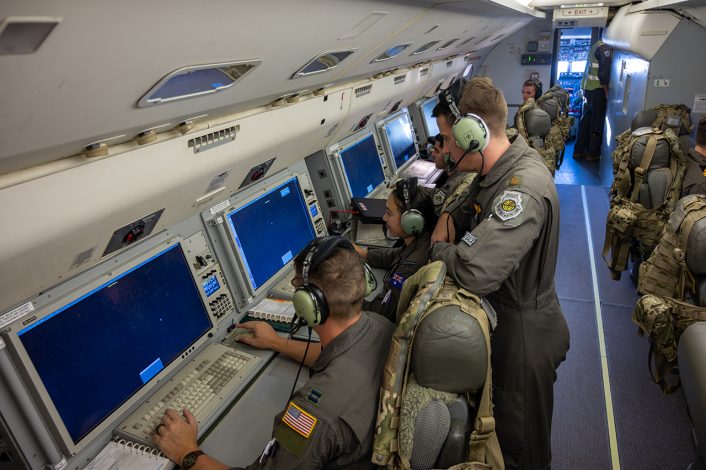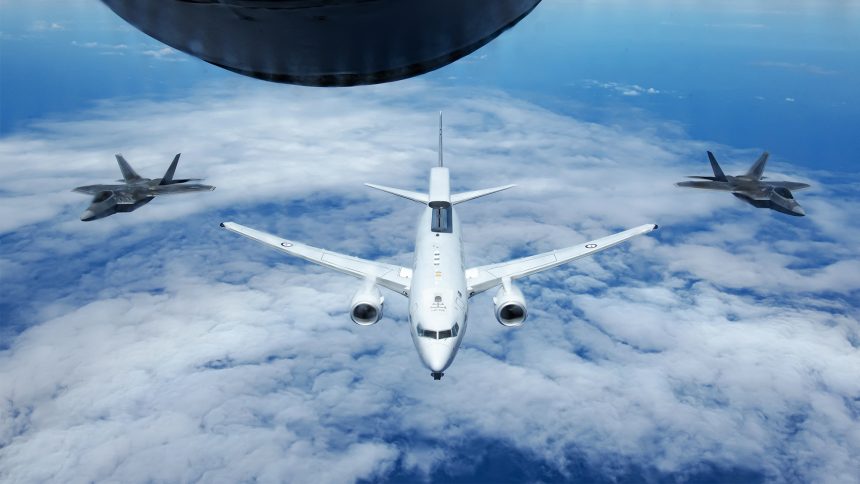Internal disagreements at the Pentagon over future direction of the AEW role could lead to the E-7 Wedgetail becoming a victim of the 2026 budget, sources tell Aviation Week.
Elements inside the U.S. Department of Defense, as reported by Aviation Week, favor a dramatic shift in focus from aircraft to satellites for the U.S. military’s future aerial surveillance requirements. The U.S. Space Force plans to begin fielding satellite-based ground moving target indicator (GMTI) systems in the 2030s, and are investigating the possibility of also integrating airborne moving target indicator (AMTI) radar capabilities onto space-based platforms.
Satellite constellations could grant the U.S. an effectively global, persistent aerial surveillance capability, superseding requirements for many airborne and ground-based radar systems.
However, critics of this philosophy argue that the command and control (C2) elements offered by platforms including the E-7A Wedgetail, using dedicated observers and controllers in the rear of the aircraft interpreting radar data in real time, offers a unique and currently irreplaceable capability.

Despite the doubts inside the Pentagon, Boeing continues to press ahead with the E-7 and intends to complete the first flight of a U.S. Air Force example in the near future. Emerging technologies are also actively under consideration for integration onto the Air Force’s Wedgetails.
U.S. Air Force Chief of Staff David Allvin makes the case that although satellite capabilities are likely to be the solution in the future, at the present time they are not mature enough to rely on for current requirements. With the retirement of the E-6B Mercury also due in the coming years, the Boeing 707 airframe that the E-3 is based on will become even rarer in the U.S. military and costs of continuing to operate the aging Sentry fleet will rise. If they are to be replaced, there is little room for delay.
The intended Wedgetail buy of 26 airframes will already produce a smaller fleet than the E-3 Sentry they will replace. This, then, may offer the chance for Wedgetail to become the bridge platform between aircraft and satellite-based aerial surveillance.
It should be noted that among America’s adversaries, aircraft based surveillance is still very much an in-development capability. China’s KJ-3000 airborne early warning (AEW) aircraft, based on the Xi’ian Y-20B airlifter, was recently seen in the air for the first time, while their new supercarrier will field the E-2 Hawkeye-like KJ-600.
Russia relies on a small fleet of Beriev A-50 (NATO reporting name: ‘Mainstay’) and upgraded A-50U, based on the Ilyushin Il-76 transport aircraft. At least two of these aircraft have reportedly been lost to Ukrainian military action. The newer A-100 is still at the prototype stage and is set to be equipped with an AESA radar.
And IMO even more important than all other so far posted news today, the so far blurry images of the KJ-3000 AEW are getting clearing,
Interesting, it features an IRF-probe and – in contrast to the KJ-2000 – not a fixed radar with three arrays but a large rototome with two. pic.twitter.com/7i9XLaLOde
— @Rupprecht_A (@RupprechtDeino) December 28, 2024
This is not to say that these nations may not also be investing in space-based surveillance systems – it’s more likely that they are – but that they also acknowledge the value of having a real time on-station capability with human operators interpreting data and feeding it directly to nearby forces.
A similar situation can be found with intelligence, surveillance, and reconnaissance aircraft. Though imagery, signals, and electronic intelligence has been gathered from space for decades, there is clearly still room for the operation of aircraft like the RC-135, U-2, and RQ-4 in the modern battlespace.
Despite the U-2 being scheduled for retirement in 2026, the Dragon Lady continues to fly daily intelligence gathering flights with varying sensor payloads from forward bases across the globe. RQ-4s and RC-135s, of course, are regularly seen via online flight tracking systems monitoring conflicts in Europe, the Middle East, and beyond.
U-2 returning to Fairford with a mission pod fitted pic.twitter.com/JjrRaj1u2W
— Brandon W 🇺🇦 🇬🇧 براندن (@Brandon71822792) February 3, 2024
With how far into development the U.S. E-7 Wedgetail program it seems unlikely that we will see a complete cancellation of the entire order. More likely, we may see the exact order numbers fluctuate as requirements are analyzed over the course of the next few years. Those who hold the purse strings may be reluctant to commit to funding the entire program straight away, leaving the U.S. Air Force requiring a gradual approach.









